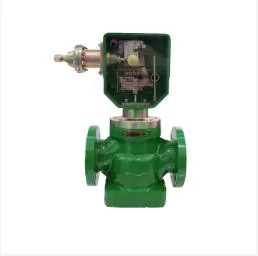
Nov . 29, 2024 15:57
Back to list
Critical Valves For Optimizing Gas Flow And Pressure Control
In industries and homes where gas and air-driven systems are essential for operation, controlling the flow and pressure of gases is crucial. Whether you're working with natural gas in heating systems, industrial applications, or automated machinery, having the right valves in place can make all the difference. Natural gas valves, pneumatic control valves, and electric regulating valves are critical components for ensuring safe, efficient, and reliable gas flow. In this article, we’ll explore how each of these valves plays a key role in optimizing system performance.

Ensuring Safety and Efficiency with a Natural Gas Valve
A natural gas valve is designed to regulate and control the flow of natural gas through pipelines, appliances, and industrial systems. Whether used in residential gas lines, commercial kitchens, or large-scale industrial operations, the natural gas valve is critical for maintaining the proper pressure and preventing gas leaks. It ensures that the gas supply is safely turned on and off, helping to avoid dangerous situations such as gas explosions or fire hazards. A high-quality natural gas valve is essential for ensuring that natural gas is delivered consistently and at the correct pressure, improving the overall safety and efficiency of the system. Whether you are managing a home heating system or operating a gas-powered turbine, a natural gas valve is a must-have for secure and reliable gas flow.
How a Pneumatic Control Valve Optimizes Air-Powered Systems
A pneumatic control valve is essential for controlling the flow of compressed air or gas in pneumatic systems. Pneumatic systems are widely used in industries such as manufacturing, automation, and HVAC, where precision control of airflow is required to power tools, actuators, and other equipment. The pneumatic control valve helps regulate the air pressure and volume delivered to the system, ensuring that the machinery operates at optimal performance levels. By adjusting the air flow, the pneumatic control valve can influence the speed, force, and motion of equipment, contributing to smoother operations and increased efficiency. In automation, robotics, and heavy machinery, a reliable pneumatic control valve is essential for consistent and precise control over air-driven components.
Why an Electric Regulating Valve is Crucial for Modern Systems
An electric regulating valve offers advanced control over the flow of gases or liquids within a system using electric actuators. Unlike traditional mechanical valves, the electric regulating valve can be integrated into automated systems and controlled remotely, providing greater precision and ease of use. Commonly used in industries like oil and gas, water treatment, and HVAC, the electric regulating valve adjusts the flow rate and pressure of gases or liquids, allowing for real-time regulation based on system demands. This means that electric regulating valves can adapt to changing conditions, improving system efficiency and energy savings. Additionally, they can be monitored and controlled via digital interfaces, offering a more hands-off and automated approach to fluid and gas regulation.
How Natural Gas Valves and Pneumatic Control Valves Work Together
In many industrial and commercial systems, both natural gas valves and pneumatic control valves are required to ensure optimal performance. For instance, in power plants or manufacturing facilities that rely on both natural gas for energy and pneumatic systems for equipment control, the natural gas valve ensures a steady and safe supply of gas, while the pneumatic control valve manages the airflow to power machinery. When these two valves work together, they help maintain consistent pressure, prevent system disruptions, and optimize energy consumption. The seamless integration of the natural gas valve and pneumatic control valve is critical for ensuring that both the gas supply and air-powered equipment operate safely and efficiently.
The Benefits of Electric Regulating Valves for Energy Savings and Automation
Electric regulating valves are transforming industries by offering improved control and energy savings. By allowing real-time, automated control of gas and liquid flows, electric regulating valves help systems adapt to varying conditions and optimize energy consumption. In gas-powered heating systems, industrial boilers, and HVAC systems, an electric regulating valve can adjust the flow of gas to match demand, ensuring that energy is used efficiently. This real-time regulation minimizes waste, reduces energy costs, and lowers the environmental impact of gas usage. Additionally, with remote monitoring capabilities, electric regulating valves enable easy integration into smart systems, further enhancing the overall performance and convenience of modern industrial and residential gas systems.
In conclusion, the natural gas valve, pneumatic control valve, and electric regulating valve are indispensable components for optimizing the performance, safety, and efficiency of gas-powered and pneumatic systems. Each of these valves serves a distinct but essential role in controlling gas flow, regulating pressure, and maintaining system integrity. By incorporating these valves into your systems, whether for residential, industrial, or commercial applications, you can ensure smoother operations, lower energy costs, and enhanced safety. Investing in high-quality valves is not just an operational necessity—it’s a step toward more sustainable and efficient energy management.
Latest news
-
Safety Valve Spring-Loaded Design Overpressure ProtectionNewsJul.25,2025
-
Precision Voltage Regulator AC5 Accuracy Grade PerformanceNewsJul.25,2025
-
Natural Gas Pressure Regulating Skid Industrial Pipeline ApplicationsNewsJul.25,2025
-
Natural Gas Filter Stainless Steel Mesh Element DesignNewsJul.25,2025
-
Gas Pressure Regulator Valve Direct-Acting Spring-Loaded DesignNewsJul.25,2025
-
Decompression Equipment Multi-Stage Heat Exchange System DesignNewsJul.25,2025

